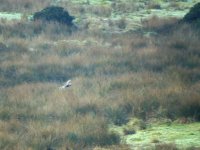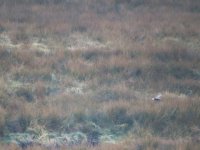-
Welcome to BirdForum, the internet's largest birding community with thousands of members from all over the world. The forums are dedicated to wild birds, birding, binoculars and equipment and all that goes with it.
Please register for an account to take part in the discussions in the forum, post your pictures in the gallery and more.
You are using an out of date browser. It may not display this or other websites correctly.
You should upgrade or use an alternative browser.
You should upgrade or use an alternative browser.
Hen Harrier ?? North Lanarkshire, Scotland (1 Viewer)
- Thread starter DG1
- Start date
More options
Who Replied?Sangahyando
Well-known member

It looks like a Hen Harrier, but the date of the picture and pictures showing the wing tips would be helpful. Assuming the picture was taken today or during the winter, Hen Harrier would by far be the likeliest option.
In any case, Marsh Harrier or other genera like buzzards or sparrowhawks etc. can be excluded.
In any case, Marsh Harrier or other genera like buzzards or sparrowhawks etc. can be excluded.
Thank you. It was quite distant, and flew out of sight before I could get a better photo. Hard to gauge size, but I would say bigger than a sparrowhawk but smaller than a buzzard.It looks like a Hen Harrier, but the date of the picture and pictures showing the wing tips would be helpful. Assuming the picture was taken today or during the winter, Hen Harrier would by far be the likeliest option.
In any case, Marsh Harrier or other genera like buzzards or sparrowhawks etc. can be excluded.
It's clearly a harrier.
It's very often useful to see photos that are simply different; quality can be much less important.The only other photo I took was even worse
TheBlackGrouse
Well-known member

The second photo, showing the broad wingtip, should be enough for Hen Harrier. It has a juvenile head but looks a bit grey. Juveniles in the Netherlands have an orange or yellow body, may be different in Scotland.Thanks for replying. I took the photo this morning. The only other photo I took was even worse than that one.
RichieTwitchy
YNWA
alirezakiani
Well-known member

I think never can be sure with such pictures. But it seems to me, more like a pallid harrier than a HH...
TheBlackGrouse
Well-known member

Another look at the first photo. When you zoom in it's clear that the collar is white. The head has a grey and white appearance. The head of the juvenile Pallid Harrier is more colorful, has some orange-buff, ochre-yellow, especially the collar.
The upper wing seems to show some orange. This combined with the broad wings and hand makes it a juvenile Hen Harrier. What I always say, a Hen Harrier looks and flies like a gull while Montagu and Pallid look and fly like terns
The upper wing seems to show some orange. This combined with the broad wings and hand makes it a juvenile Hen Harrier. What I always say, a Hen Harrier looks and flies like a gull while Montagu and Pallid look and fly like terns
Head-pattern suggests hen harrier, though the white collar seems wide. In pic 2 there's a hint of buff on the rear-underbody, and upperside of the secondaries looks rather uniform - so it may be juvenile/1st-winter for those reasons - but the photos are of low quality (no offence), there's nothing juvenile about the head/chest-pattern and -colours, and the underwing isn't visible - so personally I wouldn't age it.
TheBlackGrouse
Well-known member

About the head, when you know it's a Hen Harrier bij shape and flight, it's about the overall appearance of the head: more white (e.g. around the eye) than adult females, more contrast (instead of faint grey). It is a good field mark that's visible from hundreds of meters (with binos) when you see a grey juvenile from above, for instance from a hilltop (we Dutch birders prefer that one and only 15 meter hill that's available  ).
).
Admittedly, it is not a 100% guarantee, it helps when you have an idea about the colors and stripes on the body
Admittedly, it is not a 100% guarantee, it helps when you have an idea about the colors and stripes on the body
Last edited:


Ageing and Sexing of the Hen Harrier - Nature Observation
How to accurately determine the age and sex of “brown” hen harriers remained a mystery for a long time, despite the authors Clark and Forsman laying the groundwork some time ago.
blogs.zeiss.com
BonkleBear
New member

I’ve never seen a Hen Harrier on this side of the Clyde. I used to see a pair regularly while fishing up on the moors in South Lanarkshire. I’ll keep my eyes peeled. 👍
I've found quite a few reports of sightings of Hen Harriers in the same area as mine (around Fannyside Lochs, between Cumbernauld and Slamannan). There are often birders around looking for the Taiga Bean Geese that winter there. Later on in the year it's a good place for Cuckoos. The trees on the edge of the moor are great for Common Crossbills.I’ve never seen a Hen Harrier on this side of the Clyde. I used to see a pair regularly while fishing up on the moors in South Lanarkshire. I’ll keep my eyes peeled. 👍
BonkleBear
New member

Thanks for the info. Living in central Lanarkshire you forget how much wild and unspoiled moorland there is on our doorstep. I’ll check it out.I've found quite a few reports of sightings of Hen Harriers in the same area as mine (around Fannyside Lochs, between Cumbernauld and Slamannan). There are often birders around looking for the Taiga Bean Geese that winter there. Later on in the year it's a good place for Cuckoos. The trees on the edge of the moor are great for Common Crossbills.
Users who are viewing this thread
Total: 2 (members: 0, guests: 2)






